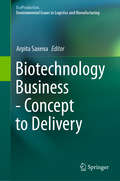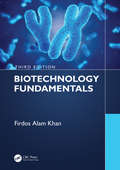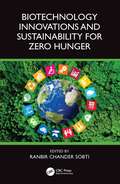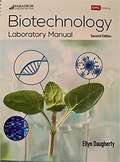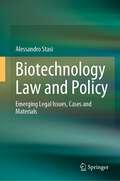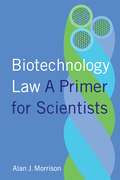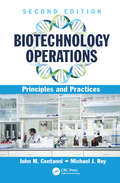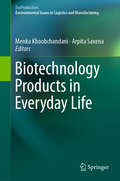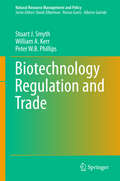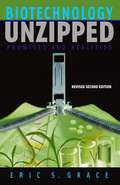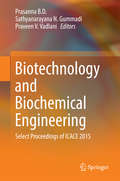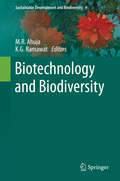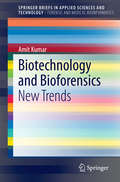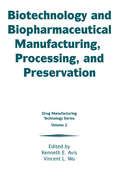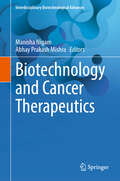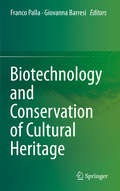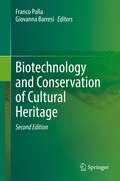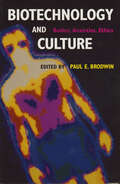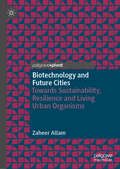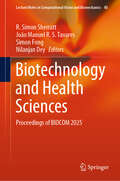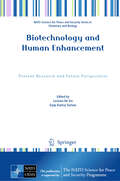- Table View
- List View
Biotechnology Business - Concept to Delivery (EcoProduction)
by Arpita SaxenaThis book is an effort to foster the entrepreneurial spirit in young minds. It reviews a wide range of product ideas, opportunities and challenges associated with start-ups. In addition, it discusses popular molecular targets for biotechnology research / the biotech industry such as attenuated microbes, gene sequences, biomarkers, and the latest advance in the sector, CRISPR. These molecular targets can be modified for the production of sufficient quantities of food and fuel. Very often, researchers limit their focus to the proof of concept, and fail to successfully convert it into a finished product. To help young entrepreneurs avoid this pitfall, the book addresses various aspects like intellectual property regulations, commerce and management. The book’s contributing authors hail from various specialized sectors, and from around the globe. Taken together, the respective chapters are intended to overcome the borders between disciplines that otherwise rarely interact.
Biotechnology Fundamentals
by Firdos Alam KhanA single source reference covering every aspect of biotechnology, Biotechnology Fundamentals, Second Edition breaks down the basic fundamentals of this discipline, and highlights both conventional and modern approaches unique to the industry. In addition to recent advances and updates relevant to the first edition, the revised work also covers ethics in biotechnology and discusses career possibilities in this growing field. The book begins with a basic introduction of biotechnology, moves on to more complex topics, and provides relevant examples along the way. Each chapter begins with a brief summary, is illustrated by simple line diagrams, pictures, and tables, and ends with a question session, an assignment, and field trip information. The author also discusses the connection between plant breeding, cheese making, in vitro fertilization, alcohol fermentation, and biotechnology. Comprised of 15 chapters, this seminal work offers in-depth coverage of topics that include: Genes and Genomics Proteins and Proteomics Recombinant DNA Technology Microbial Biotechnology Agricultural Biotechnology Animal Biotechnology Environmental Biotechnology Medical Biotechnology Nanobiotechnology Product Development in Biotechnology Industrial Biotechnology Ethics in Biotechnology Careers in Biotechnology Laboratory Tutorials Biotechnology Fundamentals, Second Edition provides a complete introduction of biotechnology to students taking biotechnology or life science courses and offers a detailed overview of the fundamentals to anyone in need of comprehensive information on the subject.
Biotechnology Fundamentals Third Edition
by Firdos Alam KhanAfter successful launching of first and second editions of Biotechnology Fundamentals, we thought let us find out the feedbacks from our esteemed readers, faculty members, and students about their experiences and after receiving their suggestions and recommendation we thought it would be great idea to write 3rd edition of the book. Being a teacher of biotechnology, I always wanted a book which covers all aspects of biotechnology, right from basics to applied and industrial levels. In our previous editions, we have included all topics of biotechnology which are important and fundamentals for students learning. One of the important highlights of the book that it has dedicated chapter for the career aspects of biotechnology and you may agree that many students eager to know what are career prospects they have in biotechnology. There are a great number of textbooks available that deal with molecular biotechnology, microbial biotechnology, industrial biotechnology, agricultural biotechnology, medical biotechnology, or animal biotechnology independently; however, there is not a single book available that deals with all aspects of biotechnology in one book. Today the field of biotechnology is moving with lightening speed. It becomes very important to keep track of all those new information which affect the biotechnology field directly or indirectly. In this book, I have tried to include all the topics which are directly or indirectly related to fields of biotechnology. The book discusses both conventional and modern aspects of biotechnology with suitable examples and gives the impression that the field of biotechnology is there for ages with different names; you may call them plant breeding, cheese making, in vitro fertilization, alcohol fermentation is all the fruits of biotechnology. The primary aim of this book is to help the students to learn biotechnology with classical and modern approaches and take them from basic information to complex topics. There is a total of 21 chapters in this textbook covering topics ranging from an introduction to biotechnology, genes to genomics, protein to proteomics, recombinant DNA technology, microbial biotechnology, agricultural biotechnology, animal biotechnology, environmental biotechnology, medical biotechnology, nanobiotechnology, product development in biotechnology, industrial biotechnology, forensic science, regenerative medicine, biosimialars, synthetic biology, biomedical engineering, computational biology, ethics in biotechnology, careers in biotechnology, and laboratory tutorials. All chapters begin with a brief summary followed by text with suitable examples. Each chapter illustrated by simple line diagrams, pictures, and tables. Each chapter concludes with a question session, assignment, and field trip information. I have included laboratory tutorials as a separate chapter to expose the students to various laboratory techniques and laboratory protocols. This practical information would be an added advantage to the students while they learn the theoretical aspects of biotechnology.
Biotechnology Innovations and Sustainability for Zero Hunger
by Ranbir Chander SobtiThis reference book extensively examines the important role of biotechnology in tackling the global challenge of achieving zero hunger. The book delves into cutting-edge advancements and challenges in food biotechnology, crop improvement, genetic engineering, and the utilization of genetically modified organisms (GMOs) in sustainable agriculture. It provides a detailed examination of biotechnological interventions aimed at enhancing the nutritional content of crops, increasing agricultural productivity, and ensuring food security. Furthermore, the book explores the application of biotechnological techniques in improving animal-based foods, including advancements in animal breeding, genetics, and disease resistance. The chapters also address the integration of traditional breeding approaches with biotechnology for developing healthier and more productive crops. Additionally, the book introduces approaches for reduction of food waste through technological solutions, and the use of automation and robotics in food processing. This book is useful for researchers, academicians, and professionals of biotechnology, agriculture, food science, and sustainability.Key Features: Covers cutting-edge biotechnological technologies for sustainable agriculture, providing solutions to address global hunger and achieve the goal of zero hunger Discusses various crop improvement techniques, including genetic engineering and genetically modified organisms Focuses on biotechnological interventions for enhancing crop productivity and nutritional value to improve food availability and quality Presents a detailed discussion of crop protection strategies and disease resistance mechanisms Provides a thorough examination of advanced technologies for improving animal-based foods and technology-based artificial meat Examines the application of biotechnological techniques in developing innovative food systems for reducing food waste
Biotechnology Laboratory Manual
by Ellyn DaughertyBiotechnology Laboratory Manual Second Edition by Ellyn Daugherty
Biotechnology Law and Policy: Emerging Legal Issues, Cases and Materials
by Alessandro StasiThis book covers an extensive range of issues raised by biotechnological advancements from a regulatory perspective. Written in a clear and readable style, its main objective is to give readers an idea of the relationship between biotechnology and law. Biotechnology advancements and their ethical, moral, economic, and social implications in different fields and the consequential normative demands on the law are crucial to this book. The chapters cover a multitude of themes and some of the most important legal issues arising in relation to biotechnology, including the historical development of a legal framework sufficient to protect public safety, the current biotechnology regulatory system, and the rules directing the primary agencies that regulate the products of biotechnology, namely the US Food and Drug Administration, the US Department of Agriculture, and the US Environmental Protection Agency, patents and IP rights in biotechnology, the regulation of human genome editing and its impact on health research, law and emerging genome editing technologies from recombinant DNA to CRISPR/Cas9, the development of legal principles to protect property rights in the human body and allow the efficient use of human tissue, organs, DNA, and cell-lines in medical research, and legal issues arising from the use of genetic engineered plants and animals.Presenting arguments that have been drawn from careful examination of various international documents and decisions made by legal institutions and judicial bodies, this book would be a valuable read for practitioners as well as academics of biotechnology law.
Biotechnology Law: A Primer for Scientists
by Alan MorrisonBiotechnology and law are inextricable. Patent, regulatory, and contract law profoundly shape the biotech industry, and each of these practice areas is deeply intertwined with the science it governs. Yet many in this industry lack even a basic grasp of these laws, jeopardizing their business success as a result.This book is an essential introduction to biotechnology law for scientists, startup founders, regulatory specialists, patent liaisons, investors, academics, students, and other nonattorneys with biotech backgrounds. It covers core topics such as patentability, patent prosecution and infringement, patent opinions, the development and FDA approval of small-molecule and biologic drugs, regulatory exclusivity, generic drugs and ANDA litigation, biosimilars and the patent dance, patent licenses, and collaboration agreements. Written with scientists in mind, Biotechnology Law is a clear, concise, and entirely practical primer on the topic, replete with straightforward, real-world examples to illustrate each key concept. Understanding the legal machinery through which science becomes business is not a luxury—it is a crucial part of a scientist’s training. Alan J. Morrison’s expert treatment embraces this new reality.
Biotechnology Operations: Principles and Practices, Second Edition
by John M. Centanni Michael J. RoyThis book describes seven areas in the field of biotechnology operations as practiced by biopharmaceutical firms and nonprofit institutions. Revisions focus upon changes that have occurred in several areas over the past six years, with emphasis on regulatory, biomanufacturing, clinical and technical information, along with processes and guidlines that have added to the discipline. Examples are increased for new technical fields such as cell and tissue engineering. Further, illustrations or figures are added to each chapter to emphasize particular points.
Biotechnology Products in Everyday Life (EcoProduction)
by Menka Khoobchandani Arpita Saxena<p>This book explores a sampling of the most powerful and enterprising efforts to achieve biotechnological goals by means of various interdisciplinary approaches. From the fabrication of extremely small units to achieve specific objectives through nano-bio-technology, to devices with artificial intelligence, gene therapy for cerebrovascular anomalies, biodegradable plastics, the use of phyto-stem cells in cosmetology, CarT cell immune therapy, targeted therapies for cancer, 3D printed bones developed by the University of Wollongong in Australia, the sickle cell chip developed by IIT Bombay, and innovative sustainable energy solutions, the book includes a colorful spectrum of reviews on current and future biotech products. <p>Gathering contributions by an international team of researchers, this book offers its audience, and particularly younger readers, revealing information on current and upcoming smart technologies.</p>
Biotechnology Regulation and Trade (Natural Resource Management and Policy #51)
by Stuart J. Smyth William A. Kerr Peter W. B PhillipsThis book discusses the regulatory and trade challenges facing the global adoption of biotechnological products and offers strategies for overcoming these obstacles and moving towards greater global food security. The first section of the book establishes the context of the conflict, discussing the challenges of global governance, international trade, and the history of regulation of genetically modified (GM) crops. In this section, the authors emphasize the shift from exclusively science-based regulation to the more socio-economically focused framework established by the Cartagena Protocol on Biosafety, which was adopted in 2000. The second section of the book provides a snapshot of the current state of international GM crop adoption and regulation, highlighting the US, Canada, and the EU. The final section of the book identifies options for breaking the gridlock of regulation and trade that presently exist. This book adds to the current literature by providing new information about innovative agricultural technologies and encouraging debate by providing an alternative to the narratives espoused by environmental non-governmental organizations. This book will appeal to students of economics, political science, and policy analysis, as well as members of regulatory agencies and agricultural industry firms.
Biotechnology Unzipped: Promises and Realities
by Eric S. GraceBiotechnology may raise more hope and fear...revelation and confusion...excitement and alarm than any other term in today's headlines. In Biotechnology Unzipped, scientist and skilled science popularizer Eric Grace helps readers understand what biotechnology is and what implications it holds for all of us. Grace offers a reader-friendly explanation of how we came to where we are--from the coining of the word "cell" in 1665 through Darwin's breakthrough insight on evolution and the unraveling of the DNA helix to the 1997 announcement of the cloning of Dolly the sheep. This book uses everyday metaphors to help readers understand the genetic code and how it works to produce every form of life. Grace deals frankly with the reality that biotechnology is first and foremost a commercial activity. Focusing on the ethical implications, he looks at the scope of public opinion, the role of the media, the vulnerability of the poor to exploitation, and the problem of patenting life itself. Grace explores the promises and realities of biotechnology in major arenas: The human body. The medical industry is today's biggest customer for biotechnology, and Grace presents its application as a continuum from the earliest experiments with skin grafting in the 1800s. He reports on the progress of gene therapy and other medical marvels--yet Grace argues that high-tech medicine does not guarantee longer, healthier lives any more than high-tech weapons guarantee world peace. The farm. Is biotechnology the answer to world hunger or is it self-serving rhetoric from agribusiness? Grace explores the reality between these two points of view through examples, including the controversy over bovine growth hormone, increased use of herbicides and pesticides, and genetic modification of plants. The environment. Biotechnology Unzipped looks at the promise of microbes cleaning up pollutants such as the Exxon Valdez spill. Alternate Selection, Newbridge Science Book Club.
Biotechnology and Biochemical Engineering: Select Proceedings of ICACE 2015
by Prasanna B. D. Sathyanarayana N. Gummadi Praveen V. VadlaniThis book serves to highlight the seamless integration of the sciences leading to sustainable technologies. Chemical engineering is one of the major disciplines catering to the societal needs in the fields of energy, environment and materials. The chapters of this book have been selected to encompass the latest in industrial biotechnology and biochemical engineering principles and applications. The chapters are included here after careful review for content and depth. The book focuses on the relatively new areas of molecular biotechnology and nanotechnology which have a strong impact at the fundamental and process levels in chemical engineering. The book also covers analytical procedures, experimental techniques and process analysis in bioprocessing, bioremediation, green separation methods, and emerging nanoparticle applications. It should be useful to students, academicians, and practitioners alike.
Biotechnology and Biodiversity: Biology, Biotechnology And Applications (Sustainable Development and Biodiversity #4)
by M. R. Ahuja K. G. RamawatThe purpose of this book is to assess the potential effects of biotechnological approaches particularly genetic modification on biodiversity and the environment. All aspects of biodiversity such as ecological diversity, species diversity and genetic diversity are considered. Higher organisms contain a specific set of linear DNA molecules called chromosomes and a complete set of chromosomes in an organism comprises its genome. The collection of traits displayed by any organism (phenotype) depends on the genes present in its genome (genotype). The appearance of any specific trait also will depend on many other factors, including whether the gene(s) responsible for the trait is/are turned on (expressed) or off, the specific cells within which the genes are expressed and how the genes, their expression and the gene products interact with environmental factors. The primary biotechnology which concerns us is that of genetic manipulation, which has a direct impact on biodiversity at the genetic level. By these manipulations, novel genes or gene fragments can be introduced into organisms (creating transgenics) or existing genes within an organism can be altered. Transgenics are a major area of concern, combining genes from different species to effectively create novel organisms. Current rates of disappearance of biological and cultural diversity in the world are unprecedented. Intensive resource exploitation due to social and economic factors has led to the destruction, conversion or degradation of ecosystems. Reversing these trends requires time to time assessment to integrate conservation and development.
Biotechnology and Bioforensics: New Trends (SpringerBriefs in Applied Sciences and Technology)
by Amit KumarThis Brief covers broad areas of Applied Biology specifically into the domains of Biotechnology/Biomedicine and Forensic Science. Chapters included here would also explain the role of bioinformatics in protein and gene characterization, modeling of the protein structure, survey related to the chromosomal effect on Human Disorders like Diabetes and Cardiac Problems. This Brief is full of Innovative Literature like Use of Microbes in Electricity Production, Brain connection to Type 2 Diabetes etc. Interesting issues in Forensic biology and the aspects of Bioforensics like STR profiling of exhumed bones makes this brief truly useful and informative for Researchers. It also includes the advancements and new ideologies in understanding crop improvements & crop quality. This Brief witnesses Innovative Research related to the Bio and Agri software development too which are capable of accelerating Insilico biological data analysis.
Biotechnology and Biopharmaceutical Manufacturing, Processing, and Preservation
by Kenneth E. Avis and Vincent L. WuIn this unique book, experts describe practices applicable to the large-scale processing of biotechnological products. Beginning with processing and bulk storage preservation techniques, the book provides strategies for improving efficiency of process campaigns of multiple products and manufacturing facilities for such processing techniques. Large-scale chromatography for the purification of biomolecules in manufacturing and lyophilization of protein pharmaceuticals are discussed. Includes a case study on blow-fill-seal processing technology and a chapter on economic and cost factors for bioprocess engineering.
Biotechnology and Biopharmaceuticals
by Rodney J. HoBiotechnology and Biopharmaceuticals: Transforming Proteins and Genes into Drugs, Second Edition addresses the pivotal issues relating to translational science, including preclinical and clinical drug development, regulatory science, pharmaco-economics and cost-effectiveness considerations. The new edition also provides an update on new proteins and genetic medicines, the translational and integrated sciences that continue to fuel the innovations in medicine, as well as the new areas of therapeutic development including cancer vaccines, stem cell therapeutics, and cell-based therapies.
Biotechnology and Cancer Therapeutics (Interdisciplinary Biotechnological Advances)
by Abhay Prakash Mishra Manisha NigamThis book explores new ground in the field of cutting-edge cancer treatment modalities by presenting contemporary biotechnological developments as a component of cancer targeting techniques. It addresses the application of modern technologies in cancer detection, targeting, and the development of therapeutic strategies across fifteen comprehensive chapters. The book emphasizes the advantages of molecular techniques for cancer therapies, such as molecular diagnosis, cell and gene therapy, and immunotherapy, with a dedicated chapter on personalized cancer therapy to critically analyze the progression toward precision strategies. The chapters cover topics such as molecular biomarkers, microRNAs, and the potential of nanomedicine in cancer treatment. The authors provide expert analysis on the latest research, offering insights into the outcomes of scientific and clinical trials. Readers will also discover discussions on drug resistance, novel molecular targets, and the integration of biotechnology in drug discovery and development. Particular attention is given to the role of epigenetics and RNA interference in cancer therapy, as well as the challenges and future prospects of personalized medicine. This book is designed specifically for oncologists, cancer biologists, researchers, academicians, and students interested in understanding the most cutting-edge biotechnological aspects of cancer therapeutics. It offers a comprehensive overview of cancer prevention, therapeutics, and treatments through the perspectives of technology, medicine, and alternative therapies. Researchers in the field of biotechnology and cancer therapy will find this book invaluable for its detailed discussions and insights into the latest advancements. It serves as a crucial tool for those working in this area, providing a valuable resource for understanding the complexities of cancer therapies and fostering progress in the field.
Biotechnology and Conservation of Cultural Heritage
by Franco Palla Giovanna BarresiThis book provides detailed insights into the role of microorganisms and microbial products in biodeterioration, conservation and restoration of cultural heritage. Topics to be discussed are microbial colonization and their growth control on both artworks and aerosol of indoor environments such as libraries or museums, as well as human health hazard from exposure to microbial agents. In addition innovative biotechnological protocols and strategies for the removal of undesired layers on artwork surfaces are described in detail. Also the advances and perspectives in this emerging biotechnological field are discussed, supported by the latest original findings.
Biotechnology and Conservation of Cultural Heritage
by Franco Palla Giovanna BarresiThis second fully updated and extended edition of Biotechnology and Conservation of Cultural Heritage provides in-depth insights into the role of different microorganisms and microbial compounds in biodeterioration, conservation and restoration of artworks and artifacts. Latest methods to detect, remove and prevent microbial colonization on artwork surfaces and in air environments of libraries and museums are discussed and illustrated by engaging case studies. Furthermore, this edition covers new case studies on Archaeobiology, exploring ways to perform the molecular biology characterization, restoring and protecting museum taxidermal specimens, preserving and guaranteeing the future integrity. Finally, the use of halloysite-nanotubes is investigated to set up innovative protocols in consolidation and long-term protection of waterlogged and archaeological wood. This book addresses to Biologists, Microbiologists, Conservation Scientists and Conservators who are interested in understanding the role of microorganisms and bioactive molecules in conservation projects.
Biotechnology and Crop Improvement: Tissue Culture and Transgenic Approaches
by Nitish KumarBiotechnology and Crop Improvement The green revolution led to the development of improved varieties of crops, especially cereals, and since then, classical or molecular breeding has resulted in the creation of economically valuable species. Thanks to recent developments in biotechnology, it has become possible to introduce genes from different sources, such as bacteria, fungi, viruses, mice and humans, to plants. This technology has made the scientific community aware of the critical role of transgenic, not only as a means of producing stress tolerant crops but also as a platform for the production of therapeutics through molecular farming. Biotechnology and Crop Improvement: Tissue Culture and Transgenic Approaches focuses on important field crops to highlight germplasm enhancement for developing resistance to newly emerging diseases, pests, nutrient- and water-use efficiency, root traits and improved tolerance to increasing temperature and introduces significant recent achievements in crop improvement using methods such as micropropagation, somaclonal variation, somatic embryogenesis, anther/pollen/embryo culture, and compressing the breeding cycle for accelerated breeding and early release of crop varieties. Plant biotechnology has now become an integral part of tissue culture research. The tremendous impact generated by genetic engineering and consequently of transgenic now allows us to manipulate plant genomes at will. There has indeed been a rapid development in this area with major successes in both developed and developing countries. Development of transgenic crop plants, their utilization for improved agriculture, health, ecology and environment and their socio-political impacts are currently important fields in education, research, and industry and also of interest to policy makers, social activists and regulatory and funding agencies. This work prepared with a class-room approach on this multidisciplinary subject will fill an existing gap and meet the requirements of such a broad section of readers. It describes the recent biotechnological advancement and developments in plant tissue culture and transgenic. Plant tissue culture techniques such as such as micropropagation, regeneration, somaclonal variation, somatic embryogenesis, anther/pollen/embryo culture are discussed for genetic improvement of crop plant. Transgenic techniques are discussed for developing resistance to newly emerging diseases, pests, nutrient- and water-use efficiency, root traits, and improved tolerance to increasing temperature. Key Features Shows the importance of plant tissue culture and transgenic technology on plant biology research and its application to agricultural production Provides insight into what may lie ahead in this rapidly expanding area of plant research and development Contains contributions from major leaders in the field of plant tissue culture and transgenic technology This book is devoted to topics with references at both graduate and postgraduate levels. The book traces the roots of plant biotechnology from the basic sciences to current applications in the biological and agricultural sciences, industry, and medicine. The processes and methods used to genetically engineer plants for agricultural, environmental, and industrial purposes along with bioethical and biosafety issues of the technology are vividly described in the book.
Biotechnology and Culture: Bodies, Anxieties, Ethics
by Paul E. BrodwinEssays on technology’s effect on our relationship with our bodies: “A timely and perceptive look . . . at some of the most anxiety producing issues of the day.” —Paul Rabinow, University of California, BerkeleyAs birth, illness, and death increasingly come under technological control, struggles arise over who should control the body and define its limits and capacities. Biotechnologies turn the traditional “facts of life” into matters of expert judgment and partisan debate. They blur the boundary separating people from machines, male from female, and nature from culture. In these diverse ways, they destroy the “gold standard” of the body, formerly taken for granted.Biotechnologies become a convenient, tangible focus for political contests over the nuclear family, legal and professional authority, and relations between the sexes. Medical interventions also transform intimate personal experience: giving birth, building new families, and surviving serious illness now immerse us in a web of machines, expert authority, and electronic images. We use and imagine the body in radically different ways, and from these emerge new collective discourses of morality and personal identity.This book brings together historians, anthropologists, cultural critics, and feminists to examine the broad cultural effects of technologies such as surrogacy, tissue-culture research, and medical imaging. The moral anxieties raised by biotechnologies and their circulation across class and national boundaries provide other interdisciplinary themes for discourse in these essays. The authors favor complex social dramas of the refusal, celebration, or ambivalent acceptance of new medical procedures. Eschewing polemics or pure theory, contributors show how biotechnology collides with everyday life and reshapes the political and personal meanings of the body.Contributors include Paul Brodwin, Lisa Cartwright, Thomas Csordas, Gillian Goslinga-Roy, Deborah Grayson, Donald Joralemon, Hannah Landecker, Thomas Laqueur, Robert Nelson, Susan Squier, Janelle Taylor, and Alice Wexler.“This impressive collection offers a number of rich examples of why the development of anthropological studies of science, technology, and their disruptive social effects is a leading edge of critical enquiry.” —Arthur Kleinman, Harvard University
Biotechnology and Future Cities: Towards Sustainability, Resilience and Living Urban Organisms
by Zaheer AllamThis book explores how biotechnology can lead to the reimagination of cities. In a time where the increasing adoption of technology by cities is leading to unsustainable environmental and economic concerns, biotechnology has enabled new ways of envisioning data and energy storage. Zaheer Allam thus revisits the popular concept of Smart Cities -and its associated Internet of Things (IoT) to explore how the biological sciences, coupled with technology, can be applied to cities; and in doing so, create living urban organisms on an unprecedented scale. This new concept will open up exciting avenues to providing novel solutions for climate change mitigation. The book goes on to address various potential concerns and discusses what regulatory frameworks would be needed to safely implement such a concept. It will be a useful tool for planners, policy makers and engineers as well as for researchers with in interest in the future of our cities.
Biotechnology and Health Sciences: Proceedings of BIOCOM 2025 (Lecture Notes in Computational Vision and Biomechanics #40)
by João Manuel R. S. Tavares Nilanjan Dey Simon Fong R. Simon SherrattThis book reports on timely research at the interface between biomedical engineering and intelligence technologies applied to biology and health care. It covers cutting-edge methods applied to biomechanics and robotics, EEG time series analysis, blood glucose prediction models, among others. It includes peer reviewed papers presented at the Second International Conference on Innovations in Biotechnology and Health Sciences (BIOCOM 2025), held at London, United Kingdom, during 18–19 February 2025.
Biotechnology and Human Enhancement: Present Research and Future Perspectives (NATO Science for Peace and Security Series A: Chemistry and Biology)
by Eyup Kuntay Turmus Luciano De SioThis book provides new insights in the role that biotechnology and human enhancement will play in the following years to come. Based on the experience and know-how of recognized scientists worldwide, a paradigm shift in advanced technologies is highlighted, merging academic and specialized research centers. Indeed, biotechnology and human enhancement play an essential role in emerging fields such as biosensing, medical technologies, and synthetic biology. These technologies are significant for several cross-disciplinary research activities ranging from medicine to electronics. The book promotes a visionary idea that will establish a more vital collaboration to help track down a roadmap for bringing innovative and breakthrough applications to address the key and emerging challenges for the upcoming years. The book is intended to offer a comprehensive overview for both students and experienced researchers about the main research activities developed in recent years that will help realize a more sustainable approach in modern bio-related applications.
Biotechnology and Intellectual Property Rights: Legal and Social Implications
by Kshitij Kumar SinghThis book offers a valuable contribution to contemporary legal literature, providing deep insights into the interface between law and genetics, highlighting emerging issues and providing meaningful solutions to current problems. It will be of interest to a broad readership, including academics, lawyers, policy makers and scholars engaged in interdisciplinary research. In the context of examining and analyzing the legal and social implications arising from the recent conjunction of biotechnology and intellectual property rights, the book particularly focuses on human genes and gene variations. Emphasis is placed on "patent law," as a considerable percentage of genetic inventions are covered by patents. The book presents a comparative and critical examination of patent laws and practices related to biotechnology patents in the United States, Canada, European Union and India, in order to gather the common issues and the differences between them. The international patent approach regarding biotechnology is also analyzed in light of the constant conflict between differentiation and harmonization of patent laws. The book highlights the potential gaps and uncertainties as to the scope of numerous terms such as invention, microorganisms, microbiological processes, and essential biological processes under TRIPS. Also analyzed are the social and policy implications of patents relating to genetic research tools and genetic testing. The intricacies involved in providing effective intellectual property protection to bioinformatics and genomic databases are also examined. Bearing in mind the collaborative nature of bioinformatics and genomic databases, the book evaluates the pros and cons of open biotechnology and assesses the implications of extending intellectual property rights to human genetic resources, before explaining the ownership puzzle concerning human genetic material used in genetic research.
